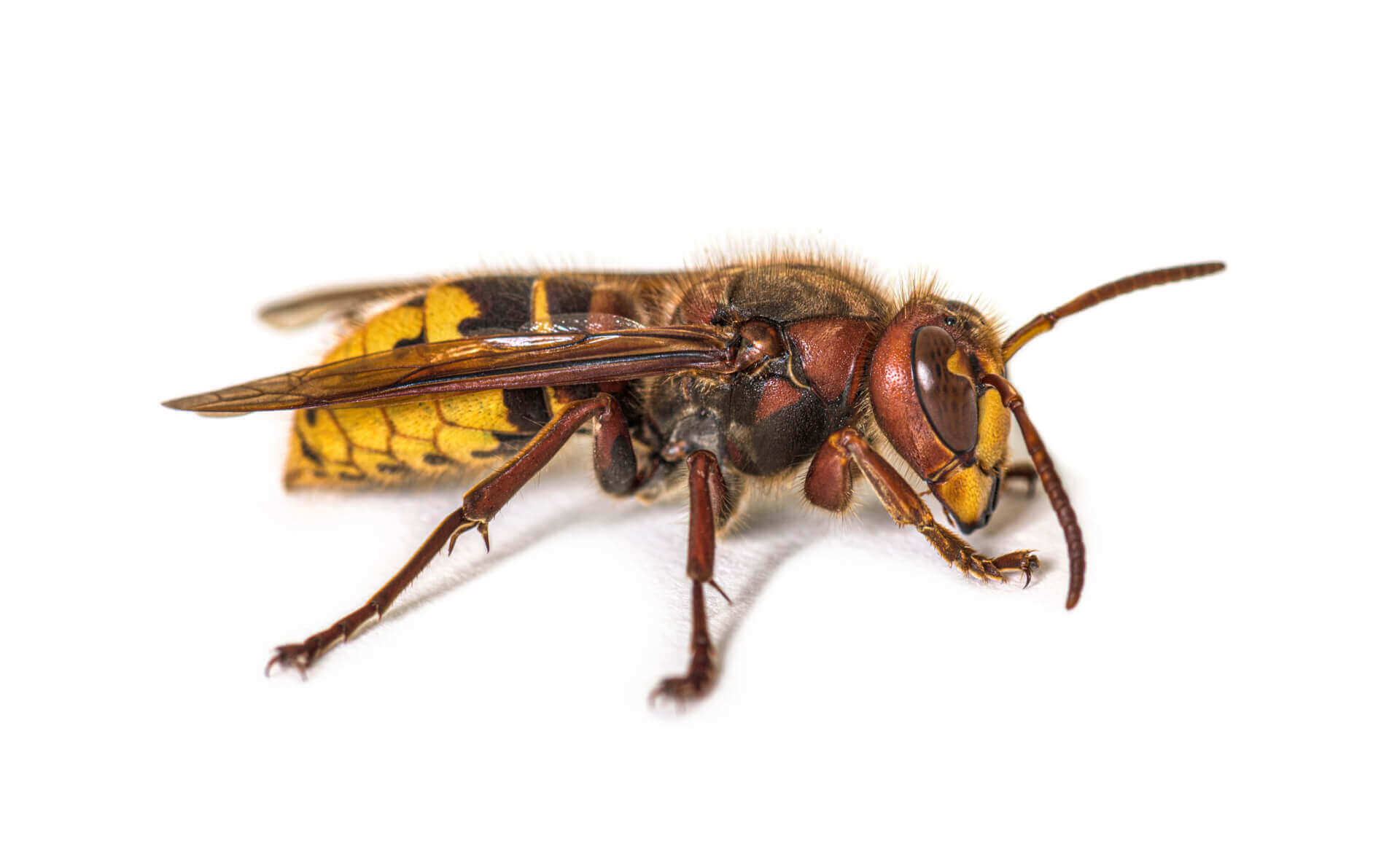Hornet Facts & Information
Everything you need to know about hornets
what do Hornets look like

Like wasps, hornets have a segmented body and a skinny waist but are more robust and much larger in size. The most common hornet in our area, the European hornet, is a very large insect.Their bodies are brown with yellow stripes on their abdomens. European hornets have pale faces. They have two pairs of wings and six legs. European hornets have long bodies and antennae. Hornets have smooth stingers, allowing them to attack multiple times. Which makes calling a hornet exterminator to get hornet removal going a good move.
Seeing large worker European hornets is a sign of an infestation. Nests in common areas such as hollow trees, attics, porches, and inside wall voids are another sign of an infestation, and may indicate that European hornet removal is necessary. Nests that are not covered by an external structure have a brown papery envelope. Nests that are sheltered have little or no envelope covering their cells. They will aggressively defend their nest, so make sure you don’t try to do it yourself.Not the stinging pest you have?
Seeing large worker European hornets is a sign of an infestation. Nests in common areas such as hollow trees, attics, porches, and inside wall voids are another sign of an infestation, and may indicate that European hornet removal is necessary. Nests that are not covered by an external structure have a brown papery envelope. Nests that are sheltered have little or no envelope covering their cells. They will aggressively defend their nest, so make sure you don’t try to do it yourself.Not the stinging pest you have?
how did i get hornets
Hornets are attracted to dead animals, whatever you have in your trash, sweet items, other pests, and a few other things that could be in and around your home. An open soda can left outside after a party (or just a Saturday) can often be seen with a hornet on it. Making sure you not only throw away all trash but clean up spills will help. Your yard probably has its fair share of pests that hornets love to feed on, too. After all, they are just looking for their next meal. Besides making sure you pick up that piece of meat that was dropped at the BBQ instead of just assuming a raccoon will have a nice meal later, you aren’t really doing anything to attract hornets that you can control. They feed on dead animals, so if there’s one nearby, you can have it removed from your property. Overall, though, you got hornets because they are out there in nature.
where do hornets live
European hornet nests are often large because the hornets themselves are large, but most nests only contain 1,500–3,000 cells. Nest size peaks in mid-September, when most nests contain 200–400 workers although large nests may have up to 1,000 workers. Like other social wasps, European hornets make annual nests. This means the nest and workers die out in the fall and the only individuals that survive are fertilized queens that construct nests the following year. Because overwintered queens construct new nests each year, having a nest in a specific tree or other area doesn’t necessarily mean a nest will be built there in the following years.
Fertilized queens overwinter in protected places, such as under the bark of fallen trees or in the wall voids of buildings. When they get into buildings and wake up in the spring, they sometimes come indoors accidentally rather than going outside, so can end up in the attic and living areas.
European hornets incorporate sugar and carbohydrates into their diet, particularly in the fall. This sometimes brings them into conflict with people when they are attracted to fallen fruit such as apples and pears or strip the bark off of certain bushes (particularly lilac) to feed on plant sap. When hornets strip the bark from bushes they can kill affected twigs and branches.
Fertilized queens overwinter in protected places, such as under the bark of fallen trees or in the wall voids of buildings. When they get into buildings and wake up in the spring, they sometimes come indoors accidentally rather than going outside, so can end up in the attic and living areas.
European hornets incorporate sugar and carbohydrates into their diet, particularly in the fall. This sometimes brings them into conflict with people when they are attracted to fallen fruit such as apples and pears or strip the bark off of certain bushes (particularly lilac) to feed on plant sap. When hornets strip the bark from bushes they can kill affected twigs and branches.
what Problems do hornets cause
Hornets are among the most dangerous of stinging insects because they can sting repeatedly. Hornets aren’t as aggressive as some other types of stinging pests, like yellow jackets, but they can still be incredibly aggressive if they, their nest, or their queen feels threatened. In addition, their venom is more toxic than other stinging pests. In some cases, an allergy can cause severe swelling, rashes, even anaphylaxis. In severe cases, hornet stings can be fatal. European hornets and other stinging insects sting to subdue prey or protect and defend their colonies. Hornets can sting repeatedly during an attack. Because European hornets have smooth stingers, they may not always detach after a sting. If the stinger becomes lodged in the skin at the site of the sting, it is important to remove the stinger as quickly as possible to curb the release of venom from the stinger.
When a sting occurs, clean the affected area thoroughly with soap and cold water and apply a cold compress or ice pack. Over the counter nonsteroidal anti-inflammatory drugs (including Aspirin, Ibuprofen, and Naproxen) may be used as needed to relieve pain. Antihistamines and hydrocortisone ointment can help soothe the local reaction. If the local reaction worsens, see a doctor for prescription oral steroids or antihistamines. If a more serious reaction occurs, seek emergency medical assistance or call 911. Those who have known allergies to European hornets or other stinging insects should acquire epinephrine kits, know how to use them, and carry them at all times.
It’s important to note that DEET and other insect repellents are not effective in protecting against European hornet stings. To prevent stings, avoid swatting at hornets. Instead, blow gently from a safe distance. Avoid attracting hornets to certain areas by keeping both food and garbage in sealed containers. Rinse out empty food containers before throwing them away.We can provide hornet treatments that will provide you, your family, your pets, your employees, and your guests with the hornet control they deserve.
When a sting occurs, clean the affected area thoroughly with soap and cold water and apply a cold compress or ice pack. Over the counter nonsteroidal anti-inflammatory drugs (including Aspirin, Ibuprofen, and Naproxen) may be used as needed to relieve pain. Antihistamines and hydrocortisone ointment can help soothe the local reaction. If the local reaction worsens, see a doctor for prescription oral steroids or antihistamines. If a more serious reaction occurs, seek emergency medical assistance or call 911. Those who have known allergies to European hornets or other stinging insects should acquire epinephrine kits, know how to use them, and carry them at all times.
It’s important to note that DEET and other insect repellents are not effective in protecting against European hornet stings. To prevent stings, avoid swatting at hornets. Instead, blow gently from a safe distance. Avoid attracting hornets to certain areas by keeping both food and garbage in sealed containers. Rinse out empty food containers before throwing them away.We can provide hornet treatments that will provide you, your family, your pets, your employees, and your guests with the hornet control they deserve.
how can i prevent hornets
Hornets are technically omnivores, so they’re capable of eating a variety of things. This means if you’ve seen hornets around your home, you could have the foods they are most attracted to accessible. Most people do tend to enjoy some of the same food items, so it’s probably unrealistic to avoid them altogether. You’ll just want to make sure you limit them. Whether it’s from a piece of meat inside your trash bin or carrion from roadkill, hornets have also been spotted taking protein from these sources. As mentioned, they are omnivores, and they tear up the meat with their mandibles. They then fly over to their nest to feed their larvae with it. So if you don’t want these bugs on your property, it’s best to clear out dead animals and put a lid on your trash. Always make sure any meat that isn’t eaten for dinner is secured inside a trash bag that doesn’t allow for insects to get inside.
Hornets are natural-born killers. They’re mostly known to be predatory creatures that eat other insects like caterpillars, bees, flies, and beetles. They hunt by overpowering their prey with their giant mandibles and stingers that can be used multiple times after they attack. Also, their size makes it possible for them to take down even larger insects like the praying mantis. Be sure to have year round pest control done so you have less pests they like to attack. Even though hornets like insects and meat protein, they also have a a sweet tooth (we know they don’t have teeth). Candy can attract hornets to camping activities and picnics, so watch out for these stinging insects when kids are eating candy outside.
While they aren’t likely to be attracted to a candy bar your child is holding, they will be attracted to candies that are left outside or unattended. If you have kids around your home, make sure any excess candy is properly disposed of in a secure trash bag to prevent hornets from having their interests around.
Hornets are natural-born killers. They’re mostly known to be predatory creatures that eat other insects like caterpillars, bees, flies, and beetles. They hunt by overpowering their prey with their giant mandibles and stingers that can be used multiple times after they attack. Also, their size makes it possible for them to take down even larger insects like the praying mantis. Be sure to have year round pest control done so you have less pests they like to attack. Even though hornets like insects and meat protein, they also have a a sweet tooth (we know they don’t have teeth). Candy can attract hornets to camping activities and picnics, so watch out for these stinging insects when kids are eating candy outside.
While they aren’t likely to be attracted to a candy bar your child is holding, they will be attracted to candies that are left outside or unattended. If you have kids around your home, make sure any excess candy is properly disposed of in a secure trash bag to prevent hornets from having their interests around.
why western for hornet control
We’re passionate about controlling hornets around your home or business because we live and work here – it’s our neighborhood, too. With our almost 100 years of experience keeping homes and businesses in Connecticut, Delaware, New Jersey, New York, and Pennsylvania safe from pests, Western has the experience you can trust.
100% Satisfaction Guarantee
24-Hour Guaranteed Response
Board Certified Entomologists
Need help with hornets?
GET A QUOTE
“We installed your Termite Defensive a number of years ago and have not seen even one termite since the system was installed.”
Edison, NJ
